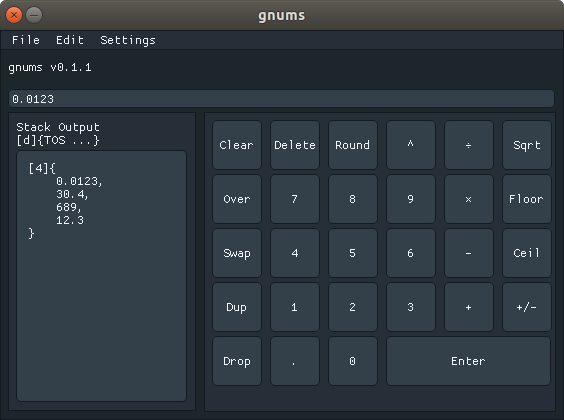|
|
||
|---|---|---|
| .gitignore | ||
| Makefile | ||
| README.md | ||
| calc.go | ||
| gnums-icon.png | ||
| gnums.desktop | ||
| gnums.png | ||
| go.mod | ||
| go.sum | ||
| main.go | ||
README.md
gnums
gnums is the gui version of my program nums (ie. gui/graphical nums). It is a reverse polish notation calculator.
Usage
On initial load some sensible defaults will be set up. Other options are avialable in the settings menu. You will see a stack view on the left, the calculator buttons on the right, and the main input/output at the top. The main input/output will show what you are typing as you type it and will show the current TOS/total after performing an operation (but before more numerical entry), similar to a regular calculator. The stack view will show the full input stack and allow for more complex operations.
At present there is no keyboard input. This is on the TODO list and should get added in the near future (after all, who really wants to use a mouse for anything?).
Most of the keys can be figured out if you don't know what they are already. I will mention that the enter key will add the currently typed in number to the top of the stack. If you have a number typed in, but have not hit enter, and you use a non-numeric/non-enter key (+, swap, sqrt, etc) the number will automatically be added to the top of the stack before the function is run.
Dependencies
- Go >= 1.16
- OSX
- xcode-select (
xcode-select --install)
- xcode-select (
- Windows
- Debian/derivatives (package names may vary for other distros)
apt install libx11-dev libxcursor-dev libxrandr-dev libxinerama-dev libxi-dev libglx-dev libgl1-mesa-dev libxxf86vm-dev
Building
Minor build variations can be found for each system. Using upx (apt install upx or brew install upx) will reduce binary size by a good bit for any of these systems. After running the build command, and optionally running upx, move the resulting binary onto your path and you are good to go.
OSX / Linux
You should be able to just run sudo make install. If you just want to build locally you can run: make && make compress
Alternatively, you can just run a few things yourself and avoid make altogether:
go build -ldflags "-s -w" -o gnums && upx gnums
You would then need to move the executable to where you want it, as well as install the desktop entry/icon (linux only).
Windows
Windows functionality and build steps are unconfirmed. As is the Makefile for windows usage. The following should work. The makefile instructions provided for OSX/Linux might work.
go build -ldflags "-s -w -H=windowsgui -extldflags=-static" -o gnums.exe
